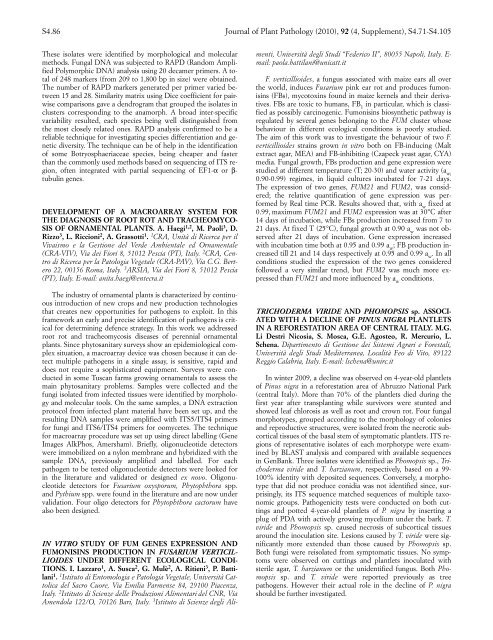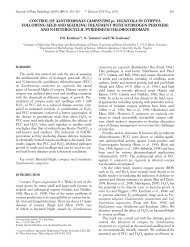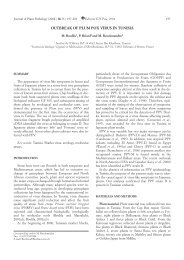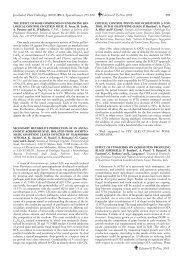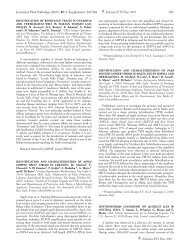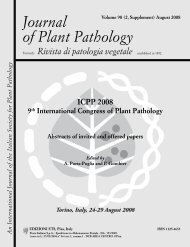Journal of Plant Pathology (2010), 92 (4, Supplement ... - Sipav.org
Journal of Plant Pathology (2010), 92 (4, Supplement ... - Sipav.org
Journal of Plant Pathology (2010), 92 (4, Supplement ... - Sipav.org
Create successful ePaper yourself
Turn your PDF publications into a flip-book with our unique Google optimized e-Paper software.
S4.86 <strong>Journal</strong> <strong>of</strong> <strong>Plant</strong> <strong>Pathology</strong> (<strong>2010</strong>), <strong>92</strong> (4, <strong>Supplement</strong>), S4.71-S4.105<br />
These isolates were identified by morphological and molecular<br />
methods. Fungal DNA was subjected to RAPD (Random Amplified<br />
Polymorphic DNA) analysis using 20 decamer primers. A total<br />
<strong>of</strong> 248 markers (from 209 to 1,800 bp in size) were obtained.<br />
The number <strong>of</strong> RAPD markers generated per primer varied between<br />
15 and 28. Similarity matrix using Dice coefficient for pairwise<br />
comparisons gave a dendrogram that grouped the isolates in<br />
clusters corresponding to the anamorph. A broad inter-specific<br />
variability resulted, each species being well distinguished from<br />
the most closely related ones. RAPD analysis confirmed to be a<br />
reliable technique for investigating species differentiation and genetic<br />
diversity. The technique can be <strong>of</strong> help in the identification<br />
<strong>of</strong> some Botryosphaeriaceae species, being cheaper and faster<br />
than the commonly used methods based on sequencing <strong>of</strong> ITS region,<br />
<strong>of</strong>ten integrated with partial sequencing <strong>of</strong> EF1-α or βtubulin<br />
genes.<br />
DEVELOPMENT OF A MACROARRAY SYSTEM FOR<br />
THE DIAGNOSIS OF ROOT ROT AND TRACHEOMYCO-<br />
SIS OF ORNAMENTAL PLANTS. A. Haegi 1,2 , M. Paoli 3 , D.<br />
Rizzo 3 , L. Riccioni 2 , A. Grassotti 1 . 1 CRA, Unità di Ricerca per il<br />
Vivaismo e la Gestione del Verde Ambientale ed Ornamentale<br />
(CRA-VIV), Via dei Fiori 8, 51012 Pescia (PT), Italy. 2 CRA, Centro<br />
di Ricerca per la Patologia Vegetale (CRA-PAV), Via C.G. Bertero<br />
22, 00156 Roma, Italy. 3 ARSIA, Via dei Fiori 8, 51012 Pescia<br />
(PT), Italy. E-mail: anita.haegi@entecra.it<br />
The industry <strong>of</strong> ornamental plants is characterized by continuous<br />
introduction <strong>of</strong> new crops and new production technologies<br />
that creates new opportunities for pathogens to exploit. In this<br />
framework an early and precise identification <strong>of</strong> pathogens is critical<br />
for determining defence strategy. In this work we addressed<br />
root rot and tracheomycosis diseases <strong>of</strong> perennial ornamental<br />
plants. Since phytosanitary surveys show an epidemiological complex<br />
situation, a macroarray device was chosen because it can detect<br />
multiple pathogens in a single assay, is sensitive, rapid and<br />
does not require a sophisticated equipment. Surveys were conducted<br />
in some Tuscan farms growing ornamentals to assess the<br />
main phytosanitary problems. Samples were collected and the<br />
fungi isolated from infected tissues were identified by morphology<br />
and molecular tools. On the same samples, a DNA extraction<br />
protocol from infected plant material have been set up, and the<br />
resulting DNA samples were amplified with ITS5/ITS4 primers<br />
for fungi and ITS6/ITS4 primers for oomycetes. The technique<br />
for macroarray procedure was set up using direct labelling (Gene<br />
Images AlkPhos, Amersham). Briefly, oligonucleotide detectors<br />
were immobilized on a nylon membrane and hybridized with the<br />
sample DNA, previously amplified and labelled. For each<br />
pathogen to be tested oligonucleotide detectors were looked for<br />
in the literature and validated or designed ex novo. Oligonucleotide<br />
detectors for Fusarium oxysporum, Phytophthora spp.<br />
and Pythium spp. were found in the literature and are now under<br />
validation. Four oligo detectors for Phytophthora cactorum have<br />
also been designed.<br />
IN VITRO STUDY OF FUM GENES EXPRESSION AND<br />
FUMONISINS PRODUCTION IN FUSARIUM VERTICIL-<br />
LIOIDES UNDER DIFFERENT ECOLOGICAL CONDI-<br />
TIONS. I. Lazzaro 1 , A. Susca 2 , G. Mulè 2 , A. Ritieni 3 , P. Battilani<br />
1 . 1 Istituto di Entomologia e Patologia Vegetale, Università Cattolica<br />
del Sacro Cuore, Via Emilia Parmense 84, 29100 Piacenza,<br />
Italy. 2 Istituto di Scienze delle Produzioni Alimentari del CNR, Via<br />
Amendola 122/O, 70126 Bari, Italy. 3 Istituto di Scienze degli Ali-<br />
menti, Università degli Studi “Federico II”, 80055 Napoli, Italy. Email:<br />
paola.battilani@unicatt.it<br />
F. verticillioides, a fungus associated with maize ears all over<br />
the world, induces Fusarium pink ear rot and produces fumonisins<br />
(FBs), mycotoxins found in maize kernels and their derivatives.<br />
FBs are toxic to humans, FB 1 in particular, which is classified<br />
as possibly carcinogenic. Fumonisins biosynthetic pathway is<br />
regulated by several genes belonging to the FUM cluster whose<br />
behaviour in different ecological conditions is poorly studied.<br />
The aim <strong>of</strong> this work was to investigate the behaviour <strong>of</strong> two F.<br />
verticillioides strains grown in vitro both on FB-inducing (Malt<br />
extract agar, MEA) and FB-inhibiting (Czapeck yeast agar, CYA)<br />
media. Fungal growth, FBs production and gene expression were<br />
studied at different temperature (T; 20-30) and water activity (a w;<br />
0.90-0.99) regimes, in liquid cultures incubated for 7-21 days.<br />
The expression <strong>of</strong> two genes, FUM21 and FUM2, was considered;<br />
the relative quantification <strong>of</strong> gene expression was performed<br />
by Real time PCR. Results showed that, with a w fixed at<br />
0.99, maximum FUM21 and FUM2 expression was at 30°C after<br />
14 days <strong>of</strong> incubation, while FBs production increased from 7 to<br />
21 days. At fixed T (25°C), fungal growth at 0.90 a w was not observed<br />
after 21 days <strong>of</strong> incubation. Gene expression increased<br />
with incubation time both at 0.95 and 0.99 a w ; FB production increased<br />
till 21 and 14 days respectively at 0.95 and 0.99 a w . In all<br />
conditions studied the expression <strong>of</strong> the two genes considered<br />
followed a very similar trend, but FUM2 was much more expressed<br />
than FUM21 and more influenced by a w conditions.<br />
TRICHODERMA VIRIDE AND PHOMOPSIS sp. ASSOCI-<br />
ATED WITH A DECLINE OF PINUS NIGRA PLANTLETS<br />
IN A REFORESTATION AREA OF CENTRAL ITALY. M.G.<br />
Li Destri Nicosia, S. Mosca, G.E. Agosteo, R. Mercurio, L.<br />
Schena. Dipartimento di Gestione dei Sistemi Agrari e Forestali,<br />
Università degli Studi Mediterranea, Località Feo di Vito, 89122<br />
Reggio Calabria, Italy. E-mail: lschena@unirc.it<br />
In winter 2009, a decline was observed on 4-year-old plantlets<br />
<strong>of</strong> Pinus nigra in a reforestation area <strong>of</strong> Abruzzo National Park<br />
(central Italy). More than 70% <strong>of</strong> the plantlets died during the<br />
first year after transplanting while survivors were stunted and<br />
showed leaf chlorosis as well as root and crown rot. Four fungal<br />
morphotypes, grouped according to the morphology <strong>of</strong> colonies<br />
and reproductive structures, were isolated from the necrotic subcortical<br />
tissues <strong>of</strong> the basal stem <strong>of</strong> symptomatic plantlets. ITS regions<br />
<strong>of</strong> representative isolates <strong>of</strong> each morphotype were examined<br />
by BLAST analysis and compared with available sequences<br />
in GenBank. Three isolates were identified as Phomopsis sp., Trichoderma<br />
viride and T. harzianum, respectively, based on a 99-<br />
100% identity with deposited sequences. Conversely, a morphotype<br />
that did not produce conidia was not identified since, surprisingly,<br />
its ITS sequence matched sequences <strong>of</strong> multiple taxonomic<br />
groups. Pathogenicity tests were conducted on both cuttings<br />
and potted 4-year-old plantlets <strong>of</strong> P. nigra by inserting a<br />
plug <strong>of</strong> PDA with actively growing mycelium under the bark. T.<br />
viride and Phomopsis sp. caused necrosis <strong>of</strong> subcortical tissues<br />
around the inoculation site. Lesions caused by T. viride were significantly<br />
more extended than those caused by Phomopsis sp.<br />
Both fungi were reisolated from symptomatic tissues. No symptoms<br />
were observed on cuttings and plantlets inoculated with<br />
sterile agar, T. harzianum or the unidentified fungus. Both Phomopsis<br />
sp. and T. viride were reported previously as tree<br />
pathogens. However their actual role in the decline <strong>of</strong> P. nigra<br />
should be further investigated.


